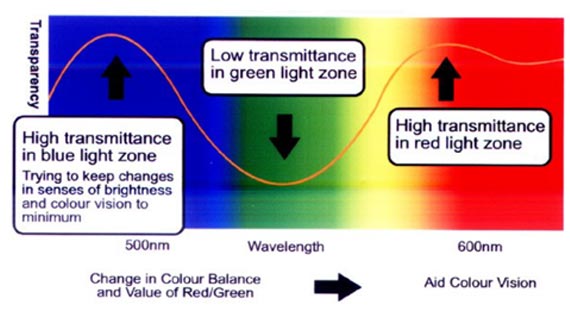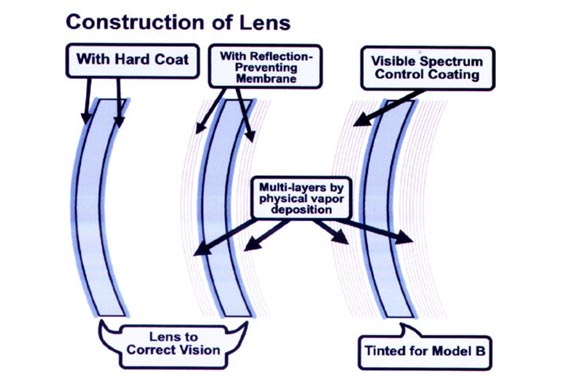
You are not Colour Blind – You are IROCHROMATICTM!
At Colour Vision Optical we don’t like the term “Colour Blind” These patients are not “Blind” they just have a colour vision deficit. And we have the perfect solution for them in the form of our revolutionary iRo lenses. Did you know – the original name for this condition was Daltonism? But now, we believe it is wrongly referred to as Colour blindness. So we use the word, IROCHROMATICTM and it is how we refer to people who have a reduced sensitivity to distinguishing differences in certain colours.
If you think about it for a minute – If glasses can help patients with Myopia, Hyperopia, Presbyopia, Astigmatism then being IROCHROMATICTM (Colour Vision Deficiency) should be added to this list, as Optometrists can treat all of these conditions with glasses. Of course refractive surgery may treat the visual disability but it is not necessarily curing the myope as they still have a myopic fundus – where the eye can still deteriorate and there’s always the slightly higher risk of Retinal Detachment, cataracts etc.
Did you know that:
In the Caucasian population 8% Males and 0.5% Females have IROCHROMATICTM vision and in Asian populations 5% Males? That relates to about 1 million people in Australia. iRo lenses will treat the majority of people who are IROCHROMATICTM specifically Deutans (sensitivity to green) and Protans (sensitivity to red) with either a mild, medium or strong deficiency. We recommend that all patients have a full eye examination to eliminate any other ocular pathology. To assess for IROCHROMATICTM vision we use the renowned:
Waggoner HRR
Richmond HRR
Ishihara
Farnsworth Dichotomous D-15
Plus we take into account the objective and subjective responses from the patient. The correct iRo lenses are then chosen through all of these mechanisms. iRo lenses really work and enable people to see the best of both worlds and give them confidence and pleasure of seeing all the beautiful colours of the world, so they can fully engage with their environment and surroundings. At Colour Vision Optical we are about giving the best colour perception you can have and the best overall visual experience when using the remarkable iRo lenses. Proudly Australian made and owned.
Treatment
iRochromaticTM
Contrary to traditional belief there is now a treatment for Colour Blindness.
There have been a number of treatments available for those with Colour Blindness. Most worked to a certain degree. After over 10 years of research, Optometrist, Ian Rosser has developed a lens which has special coatings and tints that treats 99% of all those afflicted with Colour Blindness. You can choose between an Optical Lenses for Glasses or Contact Lenses.
Technical Stuff
iRochromaticTM

Did you know 8% of males are colour blind and only 0.05% of females are colour blind!
The different kinds of CVD result from one or more of the different cone systems either not functioning at all, or functioning in an unusual way. The most common forms of CVD result from problems with either the middle or long wavelength sensitive cone systems and involve difficulties in discriminating the reds and greens and all the various shades of these colours.
PROTOS
Most receptive to the longer wavelengths (L cones) Reddish colours.
Deuterous
Most receptive to medium wavelengths (M cones) Greenish colours
Tritos
Most receptive to shorter wavelengths (S cones) Bluish colours.
Protanomaly
Mild deficiency in the sensitivity of the L cones. Being less sensitive to red light which will cause a darkening of reds to appear brown or even black in some cases.
Protanopia
Total lack of the L cones. Distinguishing shades of colours in the greenyellow-red section of the spectrum is greatly reduced.
Deuteranomaly
A mild deficiency in the sensitivity of M cones. The medium wavelength pigment is shifted towards the red end of the spectrum resulting in a reduction in sensitivity to the green area of the spectrum.
Tritanomaly
Mild deficiency is the sensitivity of the S cones. Blues and yellows will be confused.
Trianopia
Total lack of the S cones causing confusion in the blue-yellow section of the spectrum.
What Does CVD Affect?
iRochromaticTM (CVD)
A general consensus is 8% of the male population and 0.5% of females have some form of CVD. This generally runs in families, being an inherited condition. Less commonly, it can be an acquired defect through conditions such as Diabetes, Cataracts or Optic Neuritis or can be drug induced.
Our testing procedure involves first determining the type and degree of deficiency. We do this with various methods including computer based tests that each person will perform themselves. The time taken will vary but we always allow at least one hour, because after the correct lens is determined, the person will wear the lenses to see how they change and enhance their world of colours. We also encourage each person to bring along a family member or someone close to them to observe the test, as this is the defining moment when true colours are seen for the first time. Many questions can arise and it is a great time to share.
After the analysis procedure, if you are happy with the results, the lenses will be ordered for you. The lenses are available in non prescription only. For prescription spectacle wearers, a custom fitting clip-on is best and can be chosen with one of our fully trained Optical Dispensers.
Even More Technical Stuff
iRochromaticTM
Colour Vision Deficiency can be either an inherited or an acquired condition. 8% of the male population and 0.5% of the female population suffer from inherited CVD. The genetic heritage is linked to a defect in the X chromosome and usually affects every second generation of a family. Diabetes, alcoholism or certain medicines may cause acquired CVD.
CVD Father

CVD Mother

Construction Of Lenses
iRochromaticTM

This chart shows how the lenses change the spectrum of light which stimulates the cones to begin releasing the chemicals that produce the electrical signal that travels along the Optic Nerve up to the Occipital Cortex in the brain, which is then interpreted as vision, specifically colour vision.
The lenses were seven years in the research and development stage. They are manufactured in special vacuum coating chambers. Several layers are applied in the correct sequence, which is a patented process. Each layer must be perfect before the next layer is applied and so, if one layer does not adhere exactly then the whole process has to begin again with new lenses. Each batch is thoroughly inspected and must pass strict quality controls before being allowed out of the factory.
As the process is complex, only piano or non prescription lenses are produced and so for spectacle wearers the lenses are put into clip-ons over the prescription spectacles.







